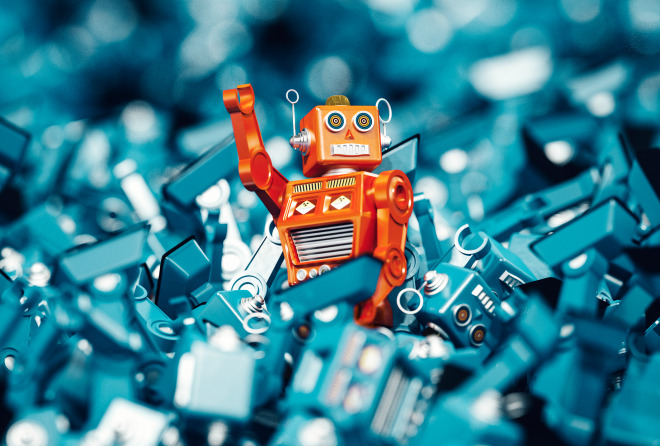From Science Fiction to Reality: The Evolution of Artificial Intelligence

What was once just a figment of the imagination of some our most famous science fiction writers, artificial intelligence (AI) is taking root in our everyday lives. We’re still a few years away from having robots at our beck and call, but AI has already had a profound impact in more subtle ways. Weather forecasts, email spam filtering, Google’s search predictions, and voice recognition, such Apple’s Siri, are all examples. What these technologies have in common are machine-learning algorithms that enable them to react and respond in real time. There will be growing pains as AI technology evolves, but the positive effect it will have on society in terms of efficiency is immeasurable.
A Lesson in History
AI isn’t a new concept; its storytelling roots go as far back as Greek antiquity. However, it was less than a century ago that the technological revolution took off and AI went from fiction to very plausible reality. Alan Turing, British mathematician and WWII code-breaker, is widely credited as being one of the first people to come up with the idea of machines that think in 1950. He even created the Turing test, which is still used today, as a benchmark to determine a machine’s ability to “think” like a human. Though his ideas were ridiculed at the time, they set the wheels in motion, and the term “artificial intelligence” entered popular awareness in the mid- 1950s, after Turing died.
American cognitive scientist Marvin Minsky picked up the AI torch and co-founded the Massachusetts Institute of Technology’s AI laboratory in 1959, and he was one of the leading thinkers in the field through the 1960s and 1970s. He even advised Stanley Kubrick on “2001: A Space Odyssey,” released in 1968, which gave the world one of the best representations of AI in the form of HAL 9000. The rise of the personal computer in the 1980s sparked even more interest in machines that think.
But it took a couple of decades for people to recognize the true power of AI. High-profile investors and physicists, like Elon Musk, founder of Tesla, and Stephen Hawking, are continuing the conversation about the potential for AI technology. While the discussion occasionally turns to potential doomsday scenarios, there is a consensus that when used for good, AI could radically change the course of human history. And that is especially true when it comes to big data.
The very premise of AI technology is its ability to continually learn from the data it collects. The more data there is to collect and analyze through carefully crafted algorithms, the better the machine becomes at making predictions. Not sure what movie to watch tonight? Don’t worry; Netflix has some suggestions for you based on your previous viewing experiences. Don’t feel like driving? Google’s working on a solution for that, too, racking up the miles on its driverless car prototype.
The Business Effect
Nowhere has AI had a greater impact in the early stages of the 21st century than in the office. Machine-learning technologies are driving increases in productivity never before seen. From workflow management tools to trend predictions and even the way brands purchase advertising, AI is changing the way we do business. In fact, a Japanese venture capital firm recently became the first company in history to nominate an AI board member for its ability to predict market trends faster than humans.
Big data is a goldmine for businesses, but companies are practically drowning in it. Yet, it’s been a primary driver for AI advancements, as machine-learning technologies can collect and organize massive amounts of information to make predictions and insights that are far beyond the capabilities of manual processing. Not only does it increase organizational efficiency, but it dramatically reduces the likelihood that a critical mistake will be made. AI can detect irregular patterns, such as spam filtering or payment fraud, and alert businesses in real time about suspicious activities. Businesses can “train” AI machines to handle incoming customer support calls, reducing costs. It can even be used to optimize the sales funnel by scanning the database and searching the Web for prospects that exhibit the same buying patterns as existing customers.
There is so much potential for AI development that it’s getting harder to imagine a future without it. We’re already seeing an increase in workplace productivity thanks to AI advancements. By the end of the decade, AI will become commonplace in everyday life, whether it’s self-driving cars, more accurate weather predictions, or space exploration. We will even see machine-learning algorithms used to prevent cyberterrorism and payment fraud, albeit with increasing public debate over privacy implications. AI will also have a strong impact in healthcare advancements due to its ability to analyze massive amounts of genomic data, leading to more accurate prevention and treatment of medical conditions on a personalized level.
But don’t expect a machine takeover with vpn any time soon. As easy as it is for machine-learning technology to self-improve, what it lacks is intuition. There’s a gut instinct that can’t be replicated via algorithms, making humans an important piece of the puzzle. The best way forward is for humans and machines to live harmoniously, leaning on one another’s strengths. Advertising is a perfect example, where machines are now doing much of the purchasing through programmatic exchanges to maximize returns on investment, allowing advertisers to focus on creating more engaging content.
While early science fiction writers might have expected more from AI at this stage, the rest of the world is generally satisfied with our progress. After all, not everyone is ready for humanoid robots or self-learning spaceships.